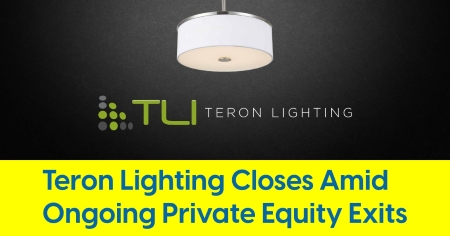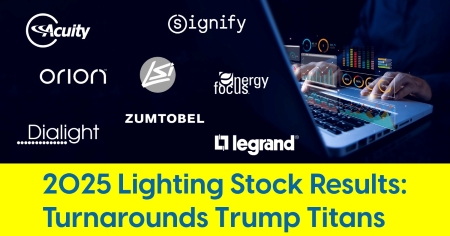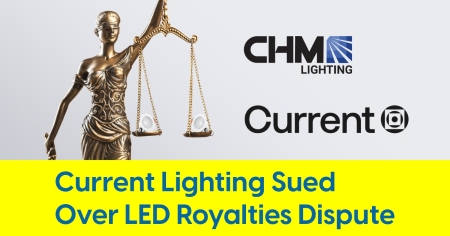September 25, 2023
Unpacking Energy Codes for Lighting Controls Applications
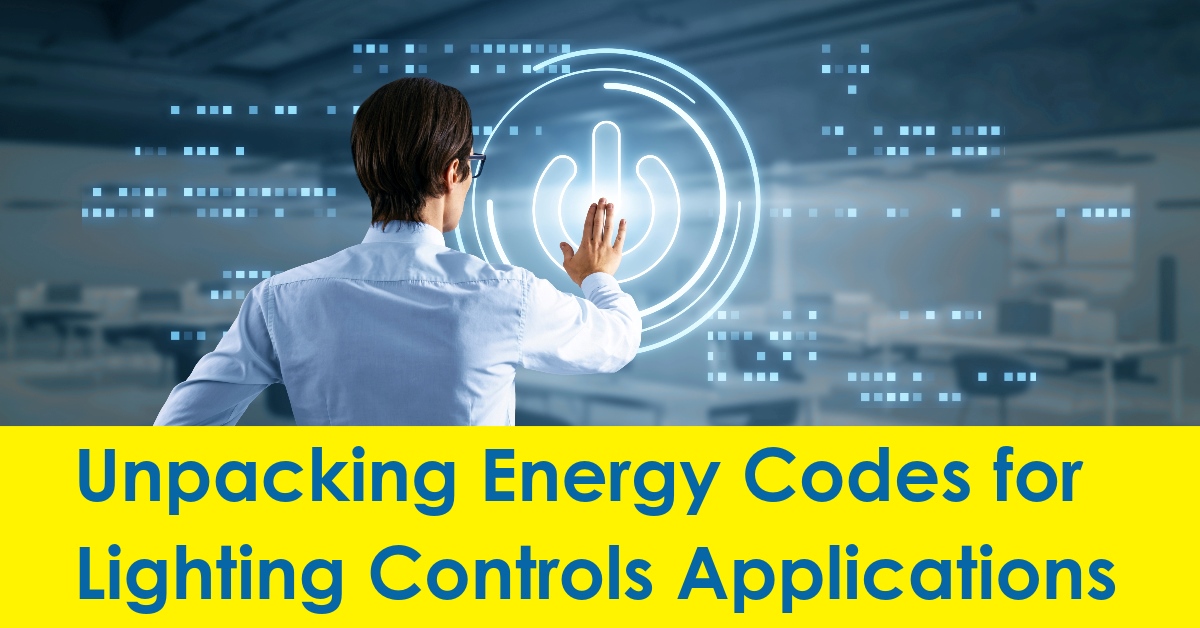
Author: Craig DiLouie, LC, CLCP is education director for the Lighting Controls Association
How IECC's models and codes are refining energy consumption and lighting practices
Commercial building energy codes regulate the design energy efficiency of new buildings and renovations. For lighting, these codes typically prescribe maximum lighting power allowances by building or space type, with the latest recognizing the widespread maturity and viability of LED lighting. They also mandate detailed lighting control strategies that reduce or turn Off lighting when it isn’t needed, while providing manual control to occupants.
The United States does not have a national energy code. States may write their own code or adopt a model such as ANSI/ASHRAE/IES 90.1 or the International Energy Conservation Code (IECC), which are periodically updated. Some states do not have a statewide code, though adoption may occur in various jurisdictions within their borders. The result is designers who work regionally may encounter multiple codes and versions of these codes.
Published by the International Code Council (ICC), the IECC is a model residential and commercial building energy code. It is updated every three years (2000, 2003, 2006, 2009, 2012, 2015, 2018, 2021). It applies to various energy-using systems installed in building new construction, additions, and alterations, including electric lighting. For alterations, all lighting provisions must be followed for the newly installed lighting system except if less than 10% of the luminaires are replaced in a given space and these new luminaires do not increase installed lighting power. According to the ICC, the IECC is adopted or in use in 48 states. In turn, the IECC recognizes 90.1 as an alternative compliance standard, providing a choice to building designers.
While the United States does not have a national commercial building energy code, the Department of Energy (DOE) recognizes a national energy reference standard. On July 28, 2023, the 2019 version of 90.1 took effect as the new national energy reference standard, succeeding the 2016 version. By that date, all states are required to have an energy code at least as stringent as the standard, which enables them to qualify for code implementation funding.
Based on previous adoptions, around one-half of the states are expected to eventually gain compliance over time. A majority of those that comply will likely adopt the 2021 version of the IECC, which offers two compliance paths: prescriptive or total building performance, which requires modeling.
Based on a new Lighting Controls Association Education Express course, this article provides general introductory knowledge about the lighting control requirements in the 2021 version of the IECC (as initially published, without addenda). For complete information—such as details and exceptions to various requirements—and definitive interpretations, consult the code and the authority having jurisdiction, or AHJ. For education credit, please visit Education Express and complete the course and associated quiz.
THE 2021 IECC AND LIGHTING CONTROLS
The 2021 IECC provides a prescriptive (conformance with a set of restrictions) or performance (building modeling using software) compliance path, with the former being the focus of this course. The prescriptive compliance path features mandatory lighting control provisions requiring their use in nearly all new construction projects as well as certain alterations, both interior and exterior (Section C405.2).
Regarding lighting controls, the 2021 IECC conceptually aims to minimize energy consumption by automatically reducing or turning Off lighting when it is not being used based on three inputs: occupancy, a timed event, or ambient light level. Required lighting controls include automatic shutoff, light reduction, and daylight-responsive controls. Additionally, various manual controls are required for occupant convenience and additional energy savings with light reduction, and zoning restrictions ensure independent control of lighting where needed. General exemptions include emergency/security areas requiring continuous lighting; interior exit passageways/stairways/ramps; and normally Off emergency egress lighting.
With the 2021 version, the IECC notably added:
-
daylight-responsive control to secondary sidelit daylight zones;
-
new requirements for parking garage controls; and
-
automatic receptacle control requirements for various spaces, producing a need that may be satisfied by the lighting control system.
Otherwise, there are a number of lighting changes, many of them for clarity and consistency.
COMPLIANCE PATHS
Section 405.2
IECC defines LLLC as a “lighting system consisting of one or more luminaires with embedded lighting control logic, occupancy and ambient light sensors, wireless networking capabilities, and local override switching capability, where required.” The LLLC luminaire will be capable of independently monitoring occupancy and ambient light and then raising and lowering light output accordingly to save energy. It may also oeprate as a group or zone of luminaires, sharing sensor information and coordinating control strategies between luminaires. Configurable characteristics must include bright and dim setpoints, timeouts, fade rates, sensitivity, and wireless zoning. Incorporating lighting control functionality into the luminaire thereby may simplify code compliance.
MANUAL CONTROL
In a majority of interior spaces, occupants are to be given the means of controlling the general lighting via manual control. This may be a discrete device (C405.2.6) or be incorporated into or with an occupant sensor (C405.2.1.1). Manual controls must be placed so they are readily accessible to occupants and such that they can see controlled lights or, in the case of remote control, identify the area served by the manual control as well as the status of the lights.
An occupant sensor may be full-automatic-On if manual control would pose a safety or security risk to occupants. It may also be full-automatic-On in some specific spaces such as stairways and interior parking areas. Otherwise, generally, it must be partial-On to 50% of power or manual-On. If the occupant sensor is partial-On, the manual control allows the lights to be raised to full or turned Off. If the occupant sensor is manual On, the manual control allows the lights to be turned On and Off.
In areas where occupant sensors are not required, a time-switch control may be used (C405.2.2.1). This approach must incorporate an override manual control switch that enables the lighting in a maximum 5,000-sq.-ft. area to remain On for up to two hours. In the case of certain larger applications such as mall concourses and sports arenas, a captive key device may be used as the override switch, with the control zone configurable up to 20,000 sq.ft.

LIGHT REDUCTION
Section 405.2.3
The manual control must be capable of light reduction, with notable exceptions including luminaires controlled by occupant sensors that feature an integral manual control, by daylight-responsive controls, or by special application controls, among other exceptions. Generally speaking, if the lighting is general lighting and controlled by a time-switch control, the manual override must be capable of light reduction. The light reduction must allow the occupant to reduce lighting load by at least 50% via multilevel switching or via continuous dimming (100-20%), while producing a reasonably uniform illumination pattern. See the code for specific options.
INTERIOR AUTOMATIC SHUTOFF CONTROL
Automatic shutoff controls automatically turn Off or reduce lighting when the area is vacated, based on either occupancy or schedule. The 2021 IECC requires that interior lighting be equipped with such controls. Acceptable methods include occupant-sensing or time-switch controls.
AUTOMATIC TIME-SWITCH CONTROL
Section 405.2.2
Where occupant sensors are not specifically required, automatic time-switch controls may be used to comply with the 2021 IECC’s shutoff requirements, unless specifically exempted. These systems employ a schedule, typically implemented by a microprocessor, to signal lighting to turn Off at programmed times. This makes them well-suited to applications where occupancy adheres to a set schedule.
Time-switch controls must be able to accommodate individual scheduling for each day of the week as well as implement a holiday shutoff feature, which ensures all lighting is turned Off for at least 24 hours before resuming normally scheduled operation. The system must feature a manual switch override limited to two hours and 5,000 to 20,000 sq.ft. per control zone, depending on the application. The system must also feature program backup in the event power is interrupted.
OCCUPANT SENSOR CONTROLS
Section 4.5.2.1
Occupant sensor controls are devices that automatically turn Off lighting when an area is unoccupied. This method may be used to comply with the 2021 IECC’s shutoff requirements. In fact, occupant sensors are specifically required as the automatic shutoff method in a wide range of spaces: classrooms, conference rooms, offices, warehouse storage areas, and more.
The occupant sensor must be able to turn the lights Off within 20 minutes after the space is vacated. Though the sensor may automatically turn lighting full-On where manual operation would pose a safety or security risk or in spaces permitted by code, generally, the occupant sensor controls must either turn lighting by manual-On or partial-On to no more than 50% of lighting power. There must also be a manual control so occupants can manually turn the lighting Off when not needed.

OCCUPANT SENSORS IN WAREHOUSE STORAGE AREAS
Section C405.2.1.2
Warehouse aisles are typically intermittently occupied but may need to stay On during building operating hours for safety and security. In these spaces, the lighting in aisles must be controlled independently of other spaces via an occupant sensor that reduces lighting power to at least 50% within 20 minutes of vacancy. This allows a lower level of illumination when rack aisles are not occupied for energy efficiency, yet full-On when occupied. A manual control must be provided for occupants to turn the lights On and Off. A means of full automatic lighting shutoff must still be provided.
OCCUPANT SENSORS IN OPEN-PLAN OFFICES
Section C405.2.1.3
The 2021 IECC requires occupant sensors in offices, with special requirements for implementation in open-plan offices 300 sq.ft. and larger. In this application, the general lighting must be controlled by sensors with control zones limited to 600 sq.ft.
When a sensor in a control zone detects occupancy, it may turn the lights On to full. When this happens, the lights in unoccupied zones in the open office may stay Off or turn On to no more than 20% full power.
Within 20 minutes of a control zone being vacated, the lights must turn Off or uniformly reduce to no more than 20% full power. When all occupants have vacated all zones, the control system will turn all general lighting Off, or a time-switch may be assigned for this.
Below is a 2021 IECC-compliant lighting control solution for an open-plan office, incorporating occupant sensing, scheduling, and daylight-responsive control.
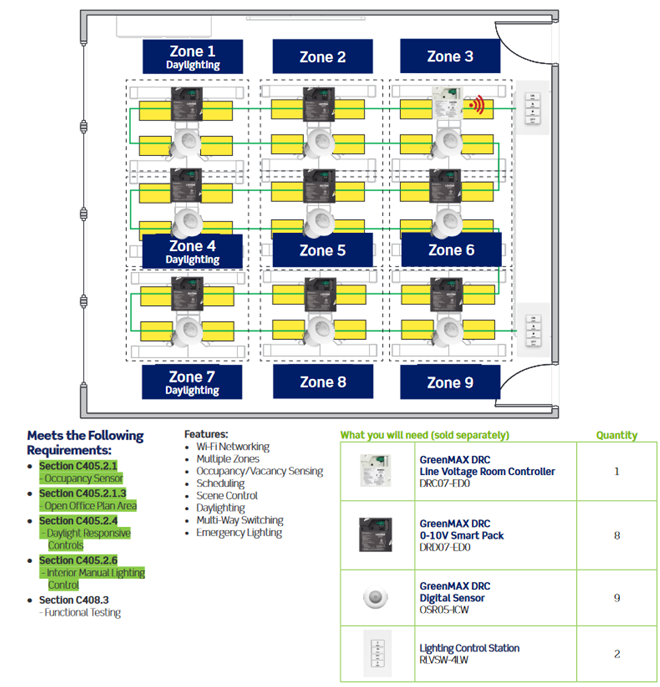
Image courtesy of Leviton
OCCUPANT SENSORS IN CORRIDORS
Section C405.2.1.4
In corridors with a light level of two footcandles or more at their darkest point on the floor, the 2021 IECC requires occupant sensors to monitor for occupancy and uniformly reduce lighting power to at least 50% full power within 20 minutes of vacancy. This measure provides energy savings while ensuring the lights remain On for safety and security.
Below is an example of a 2021 IECC-compliant control solution for a corridor, both wireless and wired.

Image courtesy of nLight, Acuity Brands
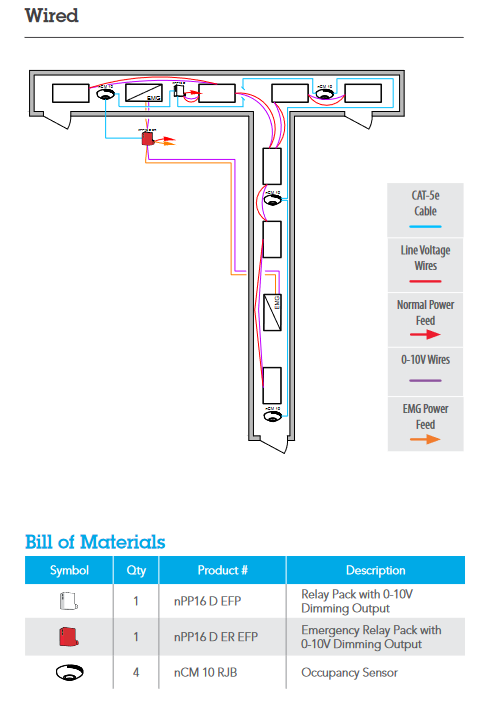
Image courtesy of nLight, Acuity Brands
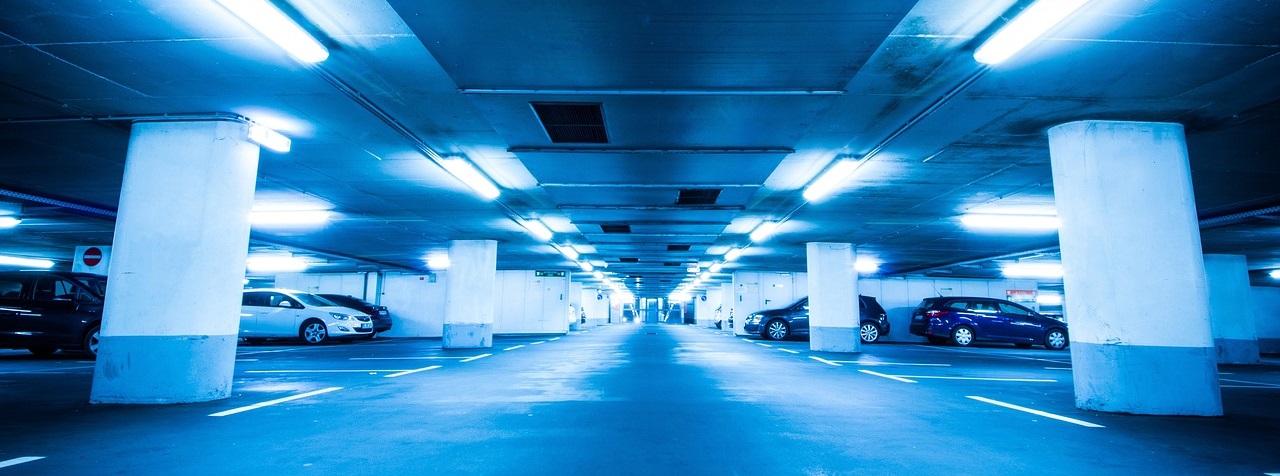
PARKING GARAGES
Parking garages are another application called out in the 2021 IECC as having special requirements for light reduction. For automatic shutoff, occupant sensing and time-switch control are recognized as acceptable methods. In addition to this, certain light reduction controls are needed, with varying exceptions that may apply.
Each luminaire must be controlled by an occupant sensor that reduces lighting power by at least 30% within 20 minutes of vacancy. Each control zone is limited to 3,600 sq.ft.
Where lighting for eye adaptation is provided at entrances and exits, these luminaires must be controlled by a device that reduces lighting power by at least 50% from sunset to sunrise.
Luminaires that are within 20 ft. of the perimeter wall openings must be automatically reduced by at least 50% in response to available daylight.
DAYLIGHT-RESPONSIVE CONTROLS
Section 405.2.4
Areas receiving ample and consistent daylight are required to have installed daylight-responsive controls, which reduce general lighting in response to daylight levels to save energy.
These areas are defined as primary sidelit (adjacent to vertical fenestration such as windows), secondary sidelit (adjacent to primary daylight zones), and toplit (under toplighting such as skylights) daylight zones.
Because daylight-responsive controls apply to the general lighting of sufficient total wattage in these daylight zones, the first step for compliance is to identify 1) daylight zones in each interior space and their dimensions, 2) how much general lighting wattage is in each zone, and 3) whether the space or area is exempt based on overall lighting design efficiency, space use, etc.
With the 2021 version, the IECC now recognizes projection factor (shading by overhanging projections) as potentially limiting the utility of implementing daylight-responsive control (as long as there are no windows about the projection). Finally, daylight zones in multi-floor atrium spaces must be established at the top floor surrounding the atrium and the bottom floor, but not any intermediate floors.
Unless exempt, general lighting totaling more than 150W in primary sidelit and toplit daylight zones and more than 300W in the combined primary and secondary sidelit zones is required to be controlled.
Once the general lighting within the daylight zones is defined, it can be controlled. The 2021 IECC requires independent automatic daylighting controls in primary and secondary sidelit and skylit daylight zones. Sidelit daylight zones may only face one cardinal direction.
The controls must be capable of reducing lighting power via continuous dimming with a dimming range of 100% to 15% of full light output or lower; they must also be capable of turning Off the controlled general lighting. If sharing an area with occupant sensors providing light reduction, the daylight-responsive controls can dim below the occupant sensor unoccupied setpoint but not raise above it. The controls must be capable of being calibrated only by authorized personnel within the space with a readily accessible means of calibration.
SPECIFIC APPLICATION CONTROLS
The 2021 IECC designates control requirements for special applications such as display lighting and supplemental task lighting. These luminaires must be controlled by either an occupant sensor or time-switch control for automatic shutoff, plus a manual control enabling them to be controlled separately from the general lighting.
Meanwhile, lighting for nonvisual applications such as plant growth must be served by an independent time-switch control. Lighting within sleeping units in buildings such as hotels must be turned OFF within 20 minutes of the room being unoccupied, along with all switched receptacles.
With the 2021 version, this IECC section now includes in its covered list of luminaires for which additional lighting power is claimed when using the Space-by-Space Method. It also includes display lighting for gallery, museum, and monument exhibit lighting that is in addition to the general lighting. Healthcare task lighting must be provided with a manual control.
CONTROLLED RECEPTACLES
Section 405.11
With the 2021 version, the IECC now contains new general receptacle control requirements.
Specifically, at least 50% of all permanently installed 125V, 15A and 20A receptacles installed in certain applications such as enclosed offices, workstations, and classrooms must be controlled. At least 25% of branch circuit feeders installed for modular furniture not shown on the plans must be controlled.
The control function may be based on split-controlled receptacles (top controlled) or separate controlled receptacles must be installed within a foot of each uncontrolled receptacle. All controlled receptacles must be marked per NFPA 70 and uniformly distributed.
The receptacles may be controlled either on a scheduled basis using a time-switch control, via an occupancy sensor with a 20-minute time delay, or via a signal from another control or alarm system.
Shown here is an example of a 2021 IECC-compliant solution providing simple vacancy sensing, daylight response, and manual dimming along with automatic receptacle control.
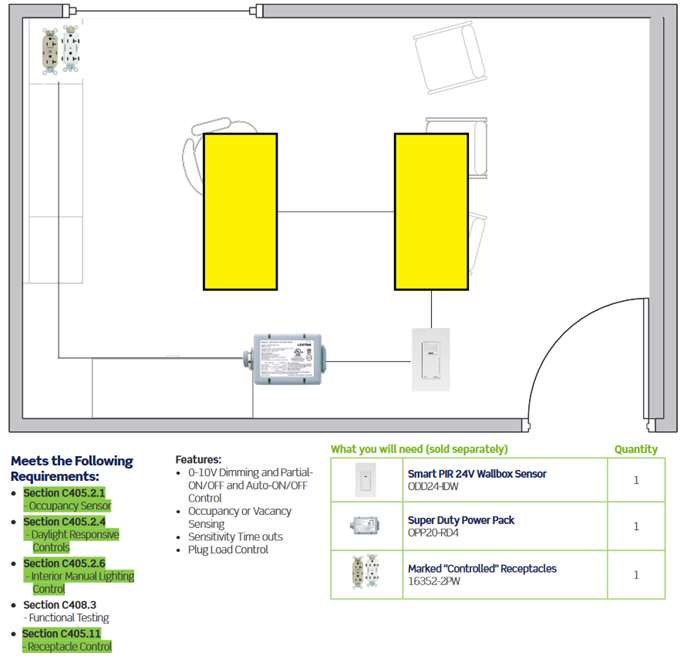
Image courtesy of Leviton
EXTERIOR LIGHTING CONTROLS
Section 405.2.7
Exterior lighting must be turned Off when sufficient daylight is present. Building façade and landscape lighting must be automatically turned Off during the night when it is no longer needed. At a minimum, it must be turned Off between midnight and 6AM, or no later than 1 hour after the closing of business operation and back On no earlier than 1 hour before business opening or operation begins.
All other exterior lighting—typically operating from dusk to dawn—must be reduced during the night based on the same time scheduling limitations as façade and landscape lighting or based on activity detection. Dusk-to-dawn lighting power must be reduced by at least 50% after hours. Outdoor parking lot luminaires greater than 78W and with a mounting height of 42 ft. or less must be controlled with an occupant sensor that reduces power by at least 50% with a 15-minute time delay. For control of such luminaires, control zoning is limited to 1500W of lighting power.
WIRELESS PARKING AREA EXAMPLE
Below is an example of a wireless 2021 IECC-compliant control solution for a parking area. Each luminaire can be independently controlled via an occupant sensor that dims to the unoccupied setpoint during vacancy and raises to the occupied setpoint during occupancy. All luminaires are controlled together in response to daylight, turning the lights Off.

Image courtesy of nLight, Acuity Brands
ADDITIONAL EFFICIENCY REQUIREMENTS
Section C406
Buildings complying with the 2021 IECC must enhance energy efficiency by choosing various options such as renewable energy and recovered or renewable water heating. Two of the options cover lighting and controls.
With the 2021 version, this table in the IECC has been expanded into a credit system. New buildings are required to gain 10 credits from among 15 options or a combination of these options. Between lighting and controls, 10 points can be gained.
For lighting, lighting power density (LPD) must be achieved that is more than 10% or 15% below the model code’s maximum lighting power density (LPD) values. This option is valued at 7-9+ credits, depending on the climate zone.
For lighting controls, digital controls must be implemented with compact control zoning of luminaires for maximum granularity of response. The digital lighting control system must be capable of continuous dimming, individual luminaire addressability, load shedding, and reconfiguration. What’s new in 2021 is giving occupants individual control of overhead general lighting is no longer required. This option is valued at 1-2 credits.
FUNCTIONAL TESTING AND DOCUMENTATION
Section C408.3
All lighting controls must be set up in accordance with approved documents and manufacturer instructions, and performance verified through functional testing. This ensures that the project team delivers a lighting and control system that operates as specified. Specific functional testing is indicated for different control types. Before a final inspection of the controls, the registered design professional must provide documentation that the lighting controls are operating in accordance with the functional testing requirements.
At the conclusion of the project, the owner must be given certain documentation about the lighting and control system so that they can maintain it. This is in addition to documentation provided by the functional testing party that the installed controls meet or exceed specified performance criteria.
Documentation requirements include a lighting and control narrative, operating and maintenance manuals, submittal data indicating all selected options for lighting and controls, a schedule for inspecting and recalibrating lighting controls, and more.
CONCLUSIONS
Commercial building energy codes continue to become increasingly restrictive in regard to lighting power and detailed in regard to controls, and the 2021 version of the IECC is no exception.
In the future, commercial building energy codes may evolve toward becoming focused on energy consumption and carbon reduction rather than initial design power and control capability. In the meantime, the 2021 IECC is likely to be adopted and used, providing designers with a minimum standard for energy efficiency.
Designers in jurisdictions that are likely to implement the 2021 version of the IECC should start to become familiar with its requirements, as there are some significant changes, particularly in regard to controls.
The Lighting Controls Association is a council of the National Electrical Manufacturers Association that provides education about lighting control technology and application, including articles, videos, design awards, news, resources, and Education Express, a free, 24/7 series of online courses covering everything from technology to design to commissioning.








